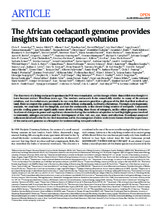| dc.contributor.author | Christoffels, Alan | |
| dc.contributor.author | Hesse, Uljana | |
| dc.contributor.author | Gamieldien, Junaid | |
| dc.contributor.author | Panji, Sumir | |
| dc.contributor.author | Picone, Barbara | |
| dc.contributor.author | Van Heusden, Peter | |
| dc.date.accessioned | 2015-06-23T07:15:10Z | |
| dc.date.available | 2015-06-23T07:15:10Z | |
| dc.date.issued | 2013 | |
| dc.identifier.citation | Amemiya, Chris T., et al. (2013). The African coelacanth genome provides
insights into tetrapod evolution. Nature, 496 (7445): 311-316 | |
| dc.identifier.issn | 0028-083 | |
| dc.identifier.uri | http://hdl.handle.net/10566/1526 | |
| dc.description.abstract | The discovery of a living coelacanth specimen in 1938 was remarkable, as this lineage of lobe-finned fish was thought to have become extinct 70 million years ago. The modern coelacanth looks remarkably similar to many of its ancient relatives, and its evolutionary proximity to our own fish ancestors provides a glimpse of the fish that first walked on land. Here we report the genome sequence of the African coelacanth, Latimeria chalumnae. Through a phylogenomic analysis, we conclude that the lungfish, and not the coelacanth, is the closest living relative of tetrapods. Coelacanth protein-coding genes are significantly more slowly evolving than those of tetrapods, unlike other genomic features. Analyses of changes in genes and regulatory elements during the vertebrate adaptation to land highlight genes involved in immunity, nitrogen excretion and the development of fins, tail, ear, eye, brain and olfaction. Functional assays of enhancers involved in the fin-to-limb transition and in the emergence of extra-embryonic tissues show the importance of the coelacanth genome as a blueprint for understanding tetrapod evolution. | en_US |
| dc.language.iso | en | en_US |
| dc.publisher | Macmillan Publishers | en_US |
| dc.rights | This work is licensed under a Creative Commons Attribution-NonCommercial-ShareAlike 3.0 Unported License.
http://creativecommons.org/licenses/by-nc-sa/3.0/ | |
| dc.source.uri | http://dx.doi.org/10.1038/nature12027 | |
| dc.subject | Coelecanth genome | en_US |
| dc.subject | Tetrapod evolution | en_US |
| dc.subject | Latimeria chalumnae | en_US |
| dc.title | The African Coelecanth genome provides insights into tetrapod evolution | en_US |
| dc.type | Article | en_US |
| dc.privacy.showsubmitter | false | |
| dc.status.ispeerreviewed | true | |
| dc.description.accreditation | Web of Science | |

